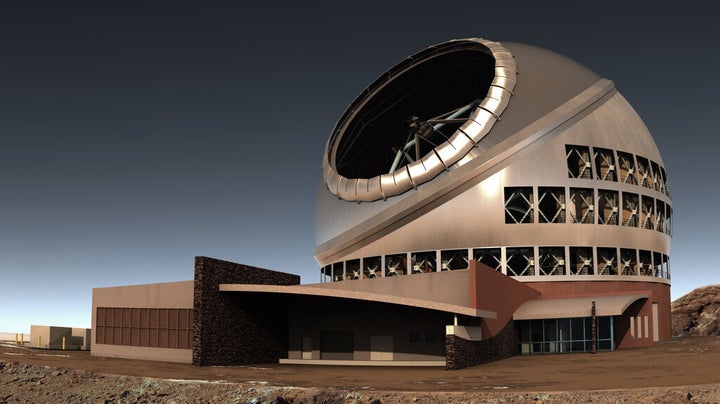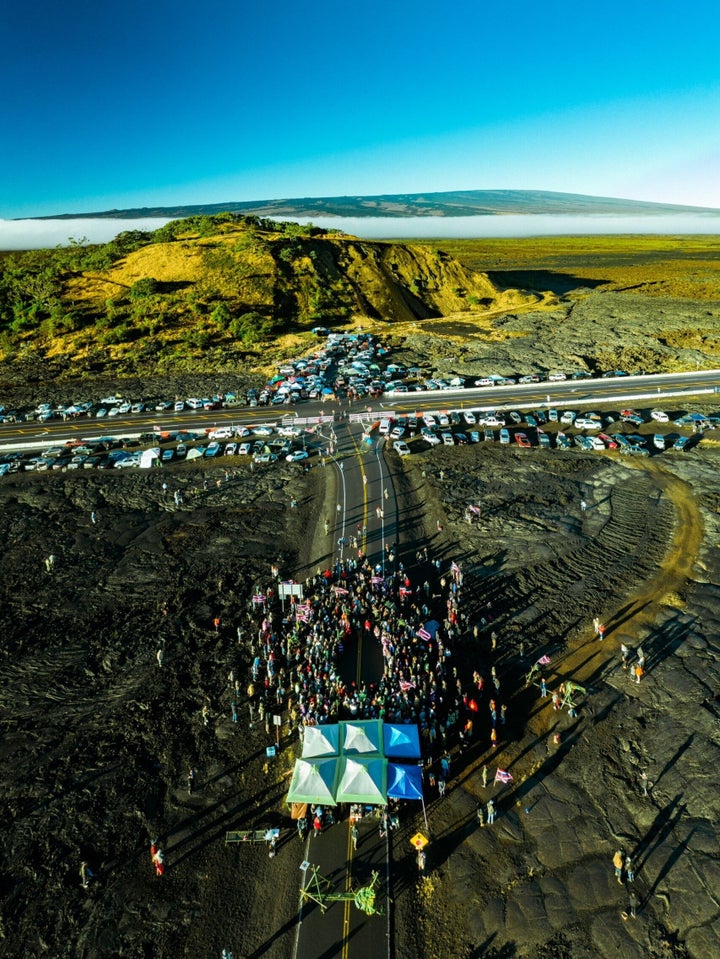On July 17, a group of Native Hawaiian activists protesting a telescope project on Mauna Kea watched as the oldest among them were carted off, one by one, by law enforcement officers.
The elderly, most of them Hawaiian, known as kūpuna, were blocking a road to the summit of the mountain, the tallest in Hawaii, as part of a larger ongoing protest against the construction of the Thirty Meter Telescope (TMT).

The kūpuna insisted on being the first ones to be arrested and asked others to remain calm, according to Kealoha Pisciotta, one of the protest’s leaders. The others watched on the side of the road, crying and chanting, as the officers arrested the elderly, including some wheelchairs or who were using canes or walkers.
Pisciotta said the arrests reflect how the ongoing protest has played out so far: emotional, respectful and tense.
“We need to show that differences can be done without violence, by really having reverence and love for each other,” Pisciotta, who has been involved in the legal battle against the telescope for years, told HuffPost.
So far, the protesters, who call themselves protectors, have been successful.
Construction was supposed to start on July 15. As of Sunday, the project remained at a standstill. The existing 13 telescopes on the summit have shut down amid the protests. More than 35 people were arrested on July 17, but no others have been since.
This fight over the $1.4 billion telescope isn’t anything new.
The current protest is just the latest time over the past five years that protectors have intervened at the construction site, and the second time they’ve halted construction altogether.
This time, though, it’s attracting even more attention nationwide, with sister protests in Nevada, California and New York. At times, up to 2,000 people appeared at the protest home base to show their support.
Actor Dwayne “The Rock” Johnson went there on Wednesday and called for better leadership from the state. Rep. Alexandria Ocasio-Cortez (D-N.Y.) and Sen. Bernie Sanders (I-Vt.) are among others who have taken notice.
Ocasio-Cortez called the resistance “something to behold.”
What’s at stake?
Everything about the TMT is massive, from its size to its potential scientific contribution.
The telescope is designed to stand 18 stories tall. Experts say it would give researchers an unprecedented look into our universe, out to galaxies formed at the beginning of time.
The project is transnational ― it’s funded by a global consortium of private companies and universities, including institutions in California, Canada, Japan, India and China, as well as the University of Hawaii.
“Maunakea is considered the best place in the Northern Hemisphere to study the universe and it remains our preferred location for TMT,” Scott Ishikawa, a spokesman for the telescope, told HuffPost in an email. “We want to begin work as soon as possible, but we recognize that this is a complex situation.”

For protesters, it’s about defending the land, not fighting the telescope.
Mauna Kea is one of the most sacred sites in Native Hawaiian spirituality. As the tallest mountain in the state, it’s seen as the origin point and the birthplace of the Hawaiian islands. Tradition has it that Wakea, the sky god, and Papa Hanau Moku, mother earth, came together there and birthed the islands.
For Native Hawaiians, Mauna Kea is a religious site, like a church, where they gather to pray and honor their ancestors.
Mauna Kea is also a conservation district with a number of fragile features: There are confirmed burial sites, it houses Hawaii’s only alpine lake, and it is home to endangered plants and animals who can only thrive at that altitude.
The mountain is also part of ceded land, once owned by the Hawaiian Kingdom, that is now held in a public land trust meant to benefit all Native Hawaiians ― on both sides of the debate.

The protest is just as much about the sacred land as it is about protecting the environment and fighting climate change.
“A really important part of Hawaiian culture is making sure that there are spaces and times where humans don’t take from the environment, because the environment needs time to regenerate itself,” Noelani Goodyear–Ka‘ōpua, a political professor at the University of Hawaii, told HuffPost.
Goodyear–Ka‘ōpua was among protesters who chained themselves to a cattle grate to block construction at the summit last week.
“The ecological state that the entire planet is in right now is because we have stressed the system to its breaking point,” she said.
Mauna Kea’s protectors are also concerned about how the project would impact a 35-acre watershed on the mountain and its aquifer, which supplies the island’s drinking water.
The Department of Land and Natural Resources say the watershed is far from the developed area and TMT officials maintain the aquifer will not be impacted.
Pisciotta doesn’t trust that those officials will be stewards of the summit, and she also doesn’t believe they’ll uphold Native Hawaiians’ traditional and customary rights promised by the state.
The Office of Hawaiian Affairs ― a semi-autonomous part of state government ― is also skeptical. In 2017, it sued the state and University of Hawaii, which holds the lease for the summit, alleging mismanagement of Mauna Kea’s summit.

TMT supporters say the observatory will enrich the state.
While the protest has attracted attention, TMT supporters ― who include Native Hawaiians ― consider themselves the silent majority in terms of public attitudes about the project.
TMT proponents held their own demonstration at the state capitol in Honolulu on Thursday, drawing dozens of supporters. They say that the observatory will create jobs (about 300 during construction and 140 when it’s in operation), diversify the economy and advance STEM education on the island.
TMT is also paying an annual lease to the state of $300,000, which will eventually increase to $1 million when the telescope is completed ― with 80% of those funds going to “stewardship” of the mountain and 20% to the Office of Hawaiian Affairs.
Miles Yoshioka, Hawaii Island Chamber of Commerce’s executive director, suggested that investments in astronomy would help the island become less dependent on the tourism industry.
“We cannot rely on tourism alone,” he told The Associated Press.
Opposition to TMT is partly about a continued betrayal of trust.
Native Hawaiians have a lot of reasons to distrust the U.S. government.
Hawaii’s path to statehood began with the illegal overthrow of the Hawaiian monarchy, during which a group of American entrepreneurs and the U.S. military held the queen captive and took over the government.
Since then, many Native Hawaiians have been disproportionately displaced in and marginalized, and elements of their culture either erased (the language was banned for nearly 100 years) or turned into a marketing ploy (a tourism boom in the 1960s led to explosive development).
But a Native Hawaiian renaissance began in the ’70s when a group of native activists protested the U.S. military’s use of the island of Kahoolawe as a practice target for bombs. (The damage was so bad, restoration efforts are still ongoing and the island remains closed to the general public.)
When the ban on Hawaiian language education was lifted in 1986, the renaissance continued, laying the groundwork for Hawaiian activism today.
Goodyear–Ka‘ōpua, who teaches Hawaiian and indigenous politics, said that’s why the protest against Mauna Kea has been so resilient ― and successful.
“I have experienced a lot of amazing expressions of Hawaiian nationhood, of Hawaiian culture, throughout my life, but nothing quite like what I’ve experienced in these past few days,” she told HuffPost.
As the protest continues, state and county officials are meeting with its leaders to try to find a resolution. But those leaders say that they have no intention of backing down.
“The TMT is non-negotiable for [state and TMT officials]. Well, at this point, building the TMT is non-negotiable for us,” Pisciotta said.
